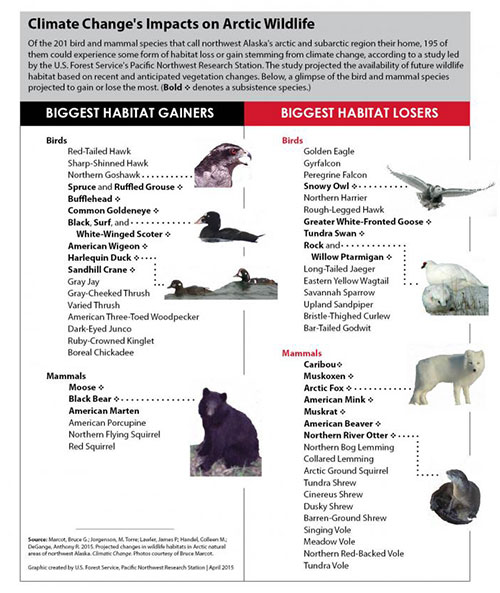
Northwest Alaska bird, mammal species could experience habitat change from warming climate
April 03, 2015
The study, which projected the effects of climate-related changes on habitats of 162 species of birds and 39 species of mammals within 40,245,559 acres of the arctic, is among the first to explore what a warming climate might mean for a wide array of bird and mammal species across a vast geographic area. The findings are published in the journal Climatic Change. "Climate is changing in the arctic far faster--by some estimates, twice as fast--than in lower-latitude temperate regions," said Bruce Marcot, a research wildlife biologist with the Pacific Northwest Research Station who led the analysis. "This makes the arctic, in a way, an 'early warning system' for the rest of the continent, making projections of changes in the region a very important scientific tool." Click on the chart to view a larger image.
The study revealed that up to 52 percent of the 201 bird and mammal species currently occurring in the area would experience habitat expansion under the models, 45 percent would see habitat contractions, and 3 percent would experience no habitat change. Species whose habitats are projected to expand include those occupying forest and tall-shrub habitats, such as grouse and black bear, while species whose habitats are projected to decline include those occupying meadow and low-shrub habitats, like ptarmigan and caribou as well as most of the small mammals that form the prey base for larger carnivores and raptors. Marcot and his colleagues also found that a greater proportion of mammal species would experience habitat declines than would bird species. In addition, half of the 50 bird and mammal species used for subsistence hunting, including greater white-fronted goose, tundra swan, caribou, mink, and muskrat would experience habitat decline. "I view our work as producing testable working hypotheses that can be validated and refined over time through further studies and monitoring," Marcot said. "It is a first approximation and not a definitive prediction of changes in wildlife population sizes to come, so continued studies will help refine our predictions and likely provide some surprises as the region continues to change."
Edited by Mary Kauffman, SitNews Editor's Note: The study was conducted in collaboration with M. Torre Jorgenson, from Alaska Ecoscience; James Lawler, from the National Park Service; and Colleen Handel and Anthony DeGange, from the U.S. Geological Survey. http://link.springer.com/article/10.1007/s10584-015-1354-x
Source of News:
|
||
